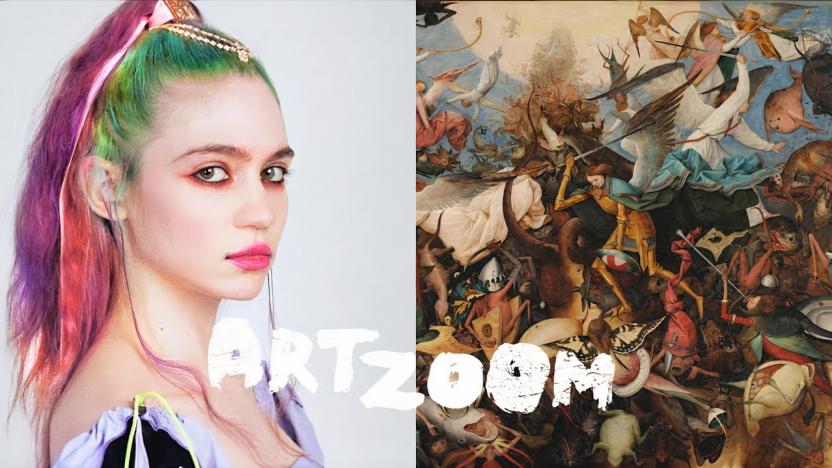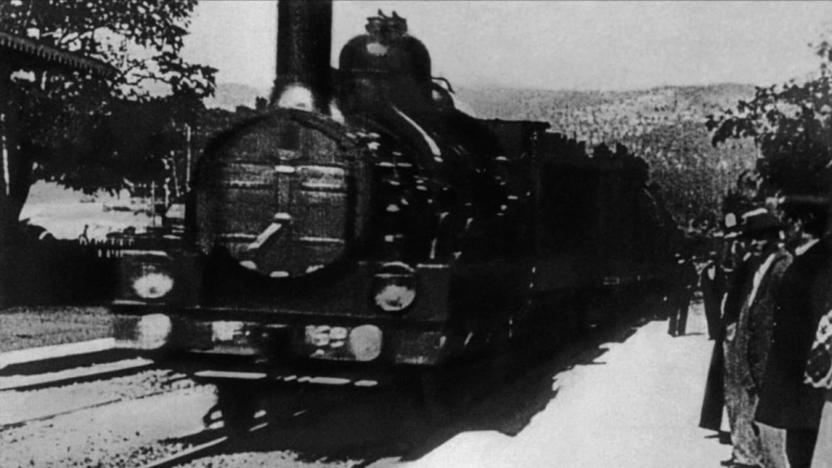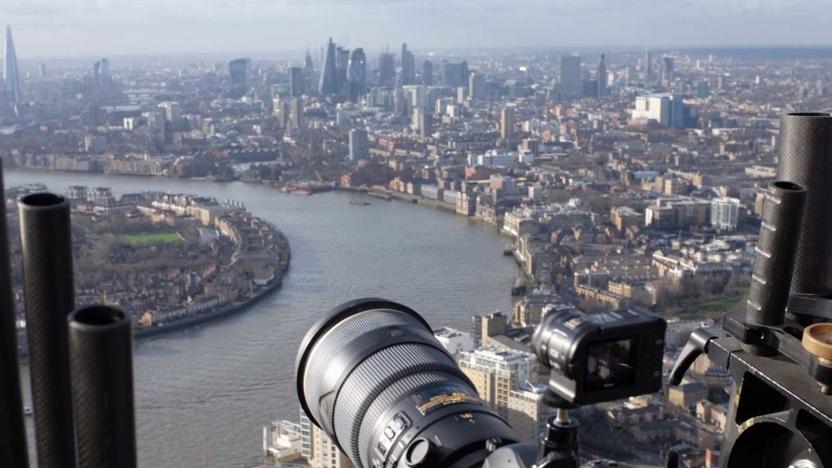gigapixel
Latest

Grimes, FKA twigs and Twice's Chaeyoung give art talks for Google
After two million people listened to musician Maggie Rogers narrate an ASMRy video about Van Gogh's Starry Night, Google has released a second season of Art Zoom. The project combines the Google Arts & Culture division’s photography with wispy narration from musicians, and the first set of videos last year also featured Feist on Bruegel, Jarvis Cocker on Monet and Girl in Red on Edvard Munch. The 1975 frontman Matty Healy gets into Mondrian’s abstract art, K-pop group Twice’s Chaeyoung narrates Yoo Youngkuk’s Mountain, while Grimes covers Bruegel’s The Fall of Rebel Angels.

Meet the Upscalers
Fans across the world are using technology to bring low-res video entertainment up to HD standards. Meet the Upscalers.

How AI helped upscale an antique 1896 film to 4K
When the 50-second silent short film L'Arrivée d'un train en gare de La Ciotat premiered in 1896, some theatergoers reportedly ran for safety at the sight of a projected approaching train, thinking that a real one would burst through the screen at any moment, Looney Tunes-style. A wild thought, given the blurry, low-resolution quality of the original film. Thankfully those panicky cinephile pioneers never saw the AI-enhanced upscaled version released by Denis Shiryaev, or they would have absolutely flipped their lids.

Gigapixel timelapse captures a day in the life of London
There's a real chance you've seen gigapixel city shots before, but they've rarely had a dynamic element -- you've had to be content with that one sliver of time. Now, there's something a little livelier. Lenstore, Nikon and Canary Wharf have partnered on what they say is the first gigapixel timelapse, 24 Hour London. As the name implies, the project provides 7.3-gigapixel snapshots of the city for every hour of the day -- you can see how the roads come to life in the day, or how Tower Bridge illuminates the night. The trick, unsurprisingly, revolves around some robotics.

World's most advanced digital camera will power the LSST telescope
If you think the 50-megapixel sensor in your new DSLR is hot stuff, you haven't seen anything yet. The Department of Energy has given the all-clear to build the Large Synoptic Survey Telecscope's 3.2-gigapixel digital camera, which promises to be the most advanced in the world. It's not just the resolution (which easily eclipses that of sophisticated airborne surveillance cams) that lets scientists make such a bold claim. It will photograph patches of sky 40 times larger than the Moon, and pick up more light than any optical telescope on Earth -- both important factors when you're trying to study the early universe, track poorly-lit asteroids and understand dark energy. While the LSST's camera won't even see its first test runs until 2019, the output could easily justify those years of work.

Record-breaking 320-gigapixel panorama of London is a cause for celebration, vertigo
While the Shard might be the new darling of London's skyline, the BT Tower's still got a few tricks up its sleeve -- such as this record-breaking 320 gigapixel panorama of the English capital. In total 48,640 images, shot with four Canon EOS 7D cameras were stitched together to create this 360 vista. Want a little more perspective? The press info claims that if this were a physical image, it would be almost as large as Buckingham Palace -- or in more concrete terms -- 60,000 times larger than an average iPhone photo. Of course, what good would a gigapixel image be without a where's waldo-style hunt? So, UK residents who have a keen eye can try spotting BT's Buzby mascot for the chance of winning some prizes. Us? We're just trying to hunt down a cab. Set your sights on the source for big picture.

DARPA's 1.8-gigapixel cam touts surveillance from 20,000 feet (video)
It's been three years since we first heard about DARPA's ARGUS-IS, but thanks to a PBS Nova special entitled "Rise of the Drones," we finally have more information about the 1.8-gigapixel camera that is supposedly the highest-resolution surveillance system in the world. The documentary showed video footage of the imaging system in action, though the camera itself remains shrouded in mystery for security reasons. Designed to be used with UAVs like the Predator, the ARGUS-IS (which stands for Autonomous Real-time Ground Ubiquitous Surveillance - Imaging System) can spot a six-inch object within a ten square mile radius from 20,000 feet in the air. As shown in the clip after the break, the high-res cam doesn't quite reveal facial features, but you can spot details like a bird flying around a building and the color of someone's clothes. The video goes on to reveal that the camera's internals are actually a collection of 368 sensors that are identical to the ones found in 5-megapixel smartphones. But the ARGUS-IS wouldn't be much without the processing power of the platform behind it. We're not entirely sure how this is done, but the camera allegedly streams around 1 million terabytes (that's an exabyte, folks) of video, which adds up to roughly 5,000 hours of HD footage per day. Thankfully, there's software that helps guys on the ground filter through the mass of data. As seen in the image above, it lets them track moving objects with up to 65 simultaneous windows. The military potential here is obvious, but DARPA is keeping mum on any future implementations of the ARGUS-IS -- or if it's been in use all this time.

US Army breaking up with A160 Hummingbird drone-copter, says it's too high maintenance
It's not me, it's you. The US Army's dalliance with Boeing's A160 Hummingbird drone got one step closer to Splitsville after the military branch issued a stop-work order for the project. Initially scheduled to see action in Afghanistan starting this July, the chopper-drone turned plenty of heads thanks to a DARPA-developed Argus-IS imaging system with a 1.8-gigapixel camera capable of spying on ground targets from 20,000 feet. The honeymoon period between the Army and the A160 is apparently over, however, thanks to a host of issues. These included wiring problems as well as excessive vibration that caused an A160 to crash earlier this year due to a transmission mount failure. The problems not only increased risk and caused delays, but also led program costs to helicopter out of control -- a big no-no given Uncle Sam's recent belt-tightening. In the meantime, the Army is reportedly checking out the K-MAX, though it's important to note that this unmanned chopper specializes in cargo and doesn't have the A160's eyes.

University researchers develop AWARE-2 camera, hope it hits the mainstream in five years
Gigapixel cameras aren't exactly hot-off-the-presses, but a few wizards at Duke and the University of Arizona may be close to getting that sort of technology into your future point-and-shoot. Reportedly, electrical engineers with gobs of free time and an imagination the size of Coach K's ego have managed to synchronize 98 minuscule cameras -- each with a 14-megapixel sensor -- "grouped around a shared spherical lens". The real kicker here is the hope for the future: these same researchers feel that "within five years, as the electronic components of the cameras become miniaturized and more efficient, the next generation of gigapixel cameras should be available to the general public." The prototype itself measures a whopping 2.5-feet square and 20 inches deep, but only around 3 percent of it is made of optical elements; the vast majority is circuitry needed to calculate the stupefying amount of information captured with such a device.

US Army's A160 Hummingbird drone-copter to don 1.8 gigapixel camera
Starting in July of 2012, the United States Army will deploy three Boeing A160 Hummingbird drones to Afghanistan as part of a one-year trial program. Unlike the Predator drones already in combat, the A160 is a rotor-based aircraft capable of vertical take-offs and landings. What's more, the craft will be affixed with the DARPA-developed ARGUS-IS imaging system -- which boasts a 1.8 gigapixel camera the Army says can "track people and vehicles from altitudes above 20,000 feet." The A160 Hummingbird platform will provide the Army with the ability and flexibility to: take off and land without a runway; fly for twelve hours or more without refueling; and monitor up to 65 enemies of the State simultaneously. Test flights of the unmanned chopper are scheduled for early 2012 in Arizona, but residents hoping to get a glimpse of the A160 in action best have great eyesight -- the ARGUS-IS system can see targets from almost 25 miles down range. Oh, and don't forget to smile when you look up. You want to look your best for the eye in the sky, right?

20 gigapixel, 360-degree panorama of Wembley Stadium is among world's largest, most detailed
Jeffrey Martin is a busy man. Having already shot an 80 gigapixel panorama of London's skyline and a 40 gigapixel peek inside a Czech library, he has now turned his attention to England's hallowed Wembley Stadium. The recently rebuilt home of football served as the stage for a new 360-degree panorama, shot during the FA Cup Final this Saturday, which spans 10 20 gigapixels in total and has been made available online at the source link below. Recording was done using a DSLR mounted to a custom robot rig that would continually pump out imagery to an equally exclusive Fujitsu workstation equipped with 192GB of RAM and 24 processing cores. All that grunt was used to automatically stitch more than 1,000 high-res images together, earning the finished product the honor of being one of the world's largest 360-degree sports panoramic photos. Give the source a bash to tag yourself if you were at the Final or to check who else was there. [Thanks, Adam] Update: We originally had this at 10 gigapixel, going from information on the FA's website, but it turns out to be a 20 gigapixel pic. Its claim for being the largest sports panorama may actually be disputed by Essendon FC in Australia, who managed to pull together a 20 gigapixel image of their own at the Melbourne Cricket Ground in late April. You can see that jumbo pic here, or check out a couple more from Daytona and the NCAA Final Four this year.

World's largest indoor photograph shows off fancy old Czech library
If you think Google's seven-gigapixel renderings of world famous art museums are impressive, get a load of this: a guy named Jeffrey Martin just produced a record breaking panoramic photo of a reading room in Prague's Strahov monastery library, and it's got the internet giant's Art Project beat by more than 30,000 megapixels. Not that Google's pictures are anything to scoff at, but the 40-gigapixel, 360 degree, 283GB image is something of a digital masterwork. According to Wired, the photograph, taken in February on a GigaPanBot-mounted Canon 550D, is comprised of 2,947 unique images that took a computer program more than four days to stitch together. If you're a fan of 18th century European literature, Franz Anton Maulbertsch's trompe l'oeil paintings, or just ridiculously detailed digital photography, you can peep the image in its entirety at the source link.

Google Art Project offers gigapixel images of art classics, indoor Street View of museums
Google's been hard at work over the past 18 months on something not many of us have been paying attention to lately: art. Specifically, the search giant has hooked up with 17 art museums around the world to offer tours of their internal galleries, using its familiar Street View tricycles, while also doing high-res images of 1,061 artworks that may be viewed on the newly launched Art Project web portal. Also there, you will find 17 special gigapixel images -- 7,000-megapixel versions of each participating venue's proudest possession. The resulting level of detail is nothing short of astounding and we've got videos of how it's all done after the break.

GigaPan wins the World Series with 1,539 megapixel zoomable image
Apparently, the US is in throes of another major sporting event. The one where male humans chase balls with sticks and gloves made from wood and cow. How do we know this? Easy, a new 79,828 X 19,290 pixel GigaPan image has just been released for you to get pervy with as the MLB invites you to scour all 1,539 megapixels for friends and family or people whom you wish were your friends or family. The image was taken over a 17-minute span and consists of 280 photos stitched together into an ultra hi-res image. You can even link the site to your Facebook account and start tagging everyone you know. Now hit the source below and let the voyeuristic zoomfest begin! [Thanks, Danny W.]

70-gigapixel panorama of Budapest becomes world's largest digital photograph
It's just been a few months since a 45-gigapixel panorama of Dubai claimed the title of world's largest digital photograph, but it's now already been well and truly ousted -- the new king in town is this 70-gigapixel, 360-degree panorama of Budapest. As with other multi-gigapixel images, this one was no easy feat, and involved two 25-megapixel Sony A900 cameras fitted with 400mm Minolta lenses and 1.4X teleconverters, a robotic camera mount from 360world that got the shooting done over the course of two days, and two solid days of post-processing that resulted in a single 200GB file -- not to mention a 15-meter-long printed copy of the photograph for good measure. Of course, what's most impressive is the photo itself. Hit up the source link below and start zooming in.

GigaPan Epic Pro helps create 44,880 megapixel panorama of Dubai skyline, world's largest digital photo
How did the world's foremost manufacturer of robotic camera mounts advertise its flagship product? Simple: it grabbed it, a Canon EOS 7D and some round-trip tickets to Dubai, and set about shooting the largest billboard in the world. Local photographer Gerald Donovan shot a nearly 45 gigapixel panorama of towering spires, desert and sky with his new GigaPan Epic Pro and a couple of the company's engineers for logistical support. You'll find the zoom-in-practically-forever image at our source link, a PR and making-of video after the break, and the cash to buy yourself a similar rig in your offshore bank account. Update: Gerald Donovan writes in to let us know that while GigaPan did help him sort out technical issues in uploading the approximately 1,000,000 images that make up the finely-detailed panorama, the company did not sponsor or commission his work. Incidentally, he's been shooting panoramas of Dubai for some time now. GigPan did revel in the aftermath, however, as a PR after the break shows.

Tromso students put together the best interactive display wall we've seen yet (video)
Take everything you thought you knew about multitouch and throw it out. Okay, keep the Minority Report stuff, but throw everything else out. What we're looking at here is a 22 megapixel display, stitched together from the output of no less than 28 projectors (7,168 x 3,072 total resolution), which just happens to respond to touch-like input in a fashion even Tom Cruise would find fascinating. You don't have to actually touch the wall, floor-mounted cameras pick up your gestures in 2D space and a 30-node computer setup crunches all the computational and visual data to deliver some buttery smooth user interaction. For demo purposes, the makers of this system grabbed a 13.3 gigapixel image of Tromso and took it for a hand-controlled spin. See the mesmerizing show on video after the break.

US Army wants 2.3 gigapixel camera for aerial surveillance
DARPA may have already gone to the trouble of building a 1.8 gigapixel camera as part of its ARGUS-IS project (pictured above), but it looks like the US Army is setting its sights a little higher, and it's now soliciting proposals for a 2.3 gigapixel camera that would be used for some super-wide aerial surveillance. While obviously still quite a ways from becoming reality, the Army hopes the system will be both smaller and lighter than previous systems, work in the infrared range to boot, and capture images at a rate of two frames per second. The key bit, however, is of course that 2.3 gigapixel sensor, which should let the camera provide continuous coverage of a range of about sixty-two square miles at a resolution of 0.3 meters, or just enough to make out the outline of your tinfoil hat.










